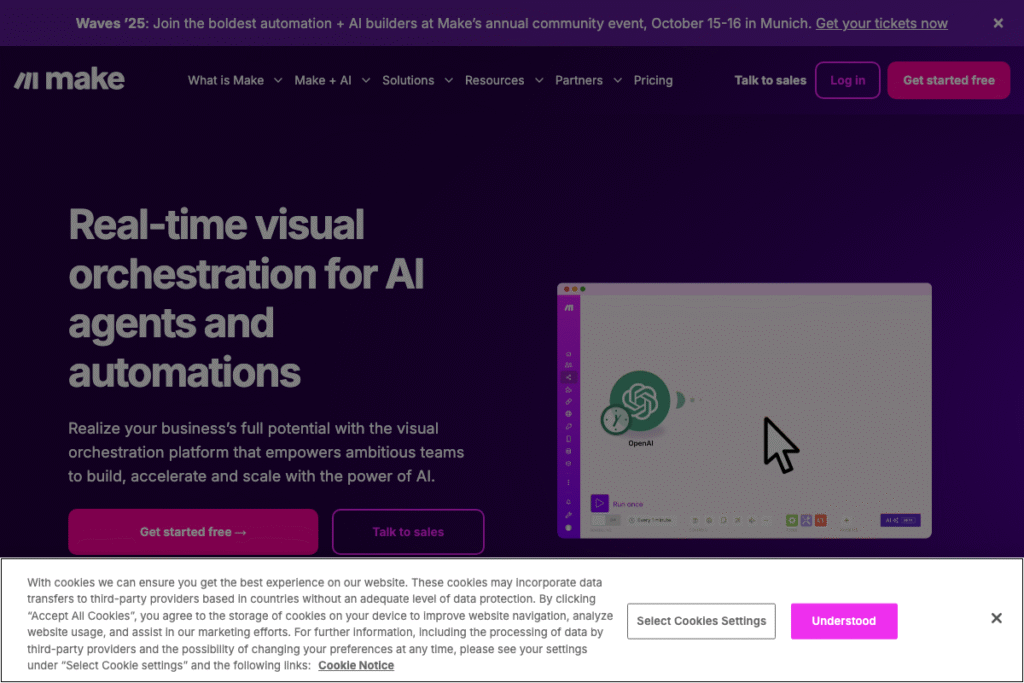Complete Make Review – Features, Pricing & Alternatives 2025 Review
What is Make?
Make (formerly Integromat) is a powerful visual automation platform that enables businesses to connect apps, automate workflows, and streamline complex processes without coding. As a European-based automation solution, Make brilliantly balances accessibility with technical capability, positioning itself as a strategic middle ground between Zapier’s simplicity and more technical platforms.
With over 2,400+ app integrations and advanced workflow capabilities, Make has become the go-to choice for businesses needing sophisticated automation solutions at competitive pricing. The platform’s visual, mind map-like interface makes complex automations intuitive while providing enterprise-grade features for scaling operations.
Key Features of Make Automation Platform
Visual Workflow Builder
Make’s standout feature is its intuitive visual interface that uses colorful app modules and animations to illustrate data flow and automation logic. Unlike traditional linear automation tools, Make allows you to create sophisticated, multi-branched workflows with conditional logic, loops, and parallel processing.
Advanced Logic Capabilities
- Conditional Branching: Create different paths based on specific criteria
- Routers & Filters: Direct data flow and apply granular control
- Iterators & Aggregators: Handle bulk data processing and collection
- Custom JavaScript: Run custom code within workflows for advanced manipulation
- Parallel Processing: Execute multiple steps simultaneously for faster operations
Extensive Integration Library
Make supports 2,400+ applications with generally more API endpoints per app than competitors. This means you can automate more specific actions within each connected app, providing deeper integration capabilities for complex business processes.
Data Manipulation Tools
The platform excels at data transformation, allowing you to change formats, merge values, perform calculations, and manipulate data directly within workflows without external tools. This eliminates the need for multiple platforms when processing data between applications.
Make Pricing Plans 2025
Make offers competitive pricing with five distinct plans designed for different business sizes and automation needs:
Free Plan
- Price: /bin/zsh/month
- Operations: 1,000 operations per month
- Features: Access to most apps, visual workflow builder, unlimited users
- Best for: Individual users and small experiments
Core Plan
- Price: Starting at .59/month
- Operations: 10,000 operations per month
- Features: Unlimited active scenarios, API endpoints, basic support
- Best for: Small businesses with moderate automation needs
Pro Plan
- Price: Starting at .82/month
- Operations: 10,000+ operations per month
- Features: Advanced features, priority support, enhanced security
- Best for: Growing businesses with complex workflows
Teams & Enterprise Plans
Higher-tier plans include advanced collaboration features, enhanced security, dedicated support, and custom operation limits. Enterprise plans offer white-label options and dedicated infrastructure for large organizations.
Make vs Zapier: Which Is Better in 2025?
Pricing Comparison
Make is significantly more cost-effective than Zapier for most use cases. While Zapier charges premium prices for advanced features, Make provides sophisticated automation capabilities at roughly 40-60% lower cost, making it attractive for businesses watching their automation budget.
Complexity and Customization
Make excels in handling complex, multi-step workflows with advanced logic, while Zapier focuses on simple, linear automations. For businesses needing conditional branching, data manipulation, and parallel processing, Make provides superior capabilities.
Learning Curve
Zapier wins for absolute beginners due to its linear, step-by-step approach. However, Make’s visual interface becomes intuitive once users understand the concept of modules and connections, often leading to more powerful automations.
Best Use Cases for Make Automation
E-commerce Automation
Perfect for managing complex e-commerce workflows including inventory management, order processing, customer communication, and multi-channel synchronization across platforms like Shopify, WooCommerce, and marketplaces.
Marketing Campaign Management
Excel at creating sophisticated marketing funnels with behavioral triggers, lead scoring, multi-channel campaign coordination, and detailed analytics collection across email, social media, and CRM platforms.
Data Processing & Reporting
Ideal for businesses needing to aggregate data from multiple sources, perform calculations, generate reports, and distribute insights across teams using tools like Google Sheets, Airtable, and business intelligence platforms.
Customer Service Automation
Streamline support workflows by connecting helpdesk systems, chat platforms, and knowledge bases to provide automated responses, ticket routing, and escalation management.
Pros and Cons of Make Platform
Advantages
- Cost-Effective: Significantly cheaper than competitors for similar functionality
- Visual Interface: Intuitive drag-and-drop workflow builder
- Advanced Features: Supports complex logic, loops, and parallel processing
- Data Manipulation: Built-in tools for transforming and processing data
- Extensive Integrations: 2,400+ apps with deep API access
- Flexible Pricing: Plans scale with usage rather than feature limitations
Disadvantages
- Learning Curve: More complex than linear automation tools
- Documentation: Can be inconsistent for advanced features
- Mobile App: Limited mobile functionality compared to web platform
- Community Size: Smaller user community than Zapier for support
Getting Started with Make in 2025
Step 1: Choose Your Plan
Start with the free plan to explore Make’s capabilities. Most small businesses find the Core plan (.59/month) sufficient for initial automation needs, while growing companies benefit from Pro plan features.
Step 2: Identify Automation Opportunities
Look for repetitive tasks, data entry processes, and multi-app workflows in your business. Common starting points include lead management, email marketing automation, and data synchronization between tools.
Step 3: Build Your First Scenario
Begin with simple, two-app automations to understand Make’s visual interface. Popular starter scenarios include connecting Google Forms to Google Sheets or synchronizing CRM contacts with email marketing platforms.
Step 4: Scale and Optimize
As you become comfortable with basic scenarios, explore Make’s advanced features like conditional logic, data manipulation, and parallel processing to create more sophisticated automations.
Make Alternatives and Competitors
Zapier
Best for beginners and simple automations, with the largest app ecosystem but higher pricing for advanced features.
n8n
Open-source alternative offering maximum customization but requiring technical expertise for setup and maintenance.
Microsoft Power Automate
Excellent for businesses already using Microsoft 365, with deep Office integration but limited third-party app support.
Automation Anywhere
Enterprise-focused RPA solution with advanced AI capabilities but significantly higher cost and complexity.
Final Verdict: Is Make Worth It in 2025?
Make represents excellent value for businesses seeking powerful automation capabilities without enterprise pricing. Its visual interface makes complex workflows manageable, while advanced features support sophisticated business processes that simpler tools cannot handle.
Choose Make if you need:
- Cost-effective automation with advanced capabilities
- Complex workflows with conditional logic and data manipulation
- Deep integration with 2,400+ applications
- Visual workflow management for better team collaboration
- Scalable solution that grows with your business needs
For businesses ready to move beyond basic automation and embrace sophisticated workflow management, Make offers the perfect balance of power, usability, and value in 2025.
Rating: 4.7/5 – Make excels in providing enterprise-grade automation capabilities at accessible pricing, making it our top recommendation for businesses serious about workflow optimization.
🔗 Related Marketing Tools
Tool 17
Explore Tool 17 features, pricing, and alternatives →
Sendible
Explore Sendible features, pricing, and alternatives →
FluentCRM
Explore FluentCRM features, pricing, and alternatives →
Tool 16
Explore Tool 16 features, pricing, and alternatives →
Tool 18
Explore Tool 18 features, pricing, and alternatives →
Lexica Art
Explore Lexica Art features, pricing, and alternatives →

